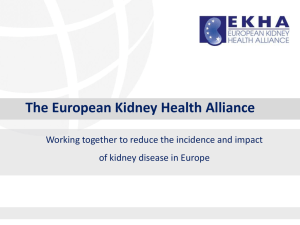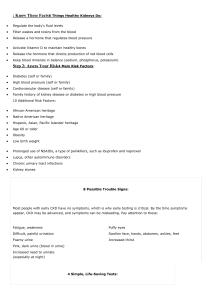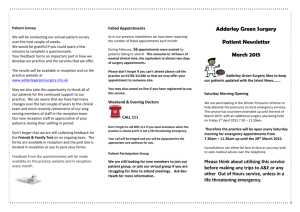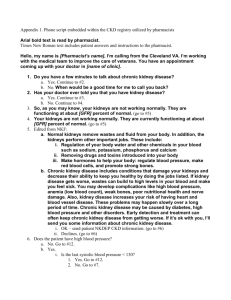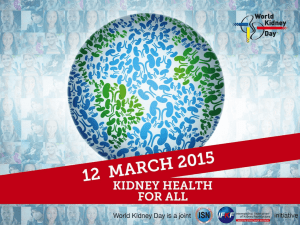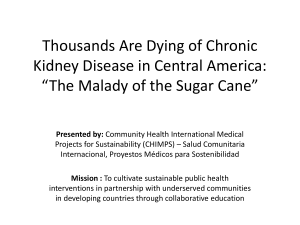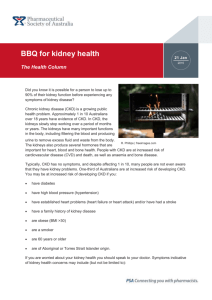Educating Chronic Kidney Disease Patients Through Health
advertisement
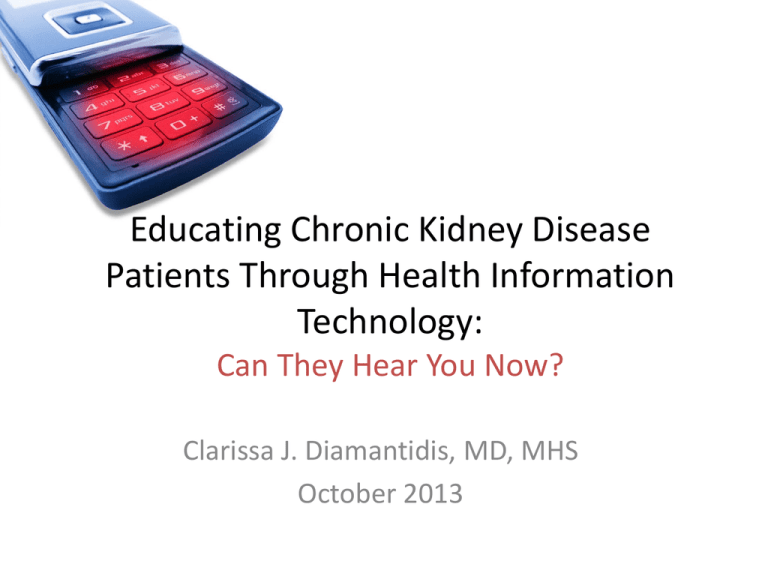
Educating Chronic Kidney Disease Patients Through Health Information Technology: Can They Hear You Now? Clarissa J. Diamantidis, MD, MHS October 2013 Chronic Kidney Disease (CKD) Coresh J, et al. JAMA. 2007. CKD Care Barriers • • • • • Low patient awareness Limited health literacy Poor patient-provider communication Low self-reported medication adherence Differential outcomes for ethnic/racial minorities Patient Safety • Reduced GFR affects drug clearance • Significant comorbidity burden • Frequent outpatient and inpatient encounters • Polypharmacy Patient-centered Health IT Healthcare Provider Social Networking/ Support Groups Personal Health Record CKD Patient Appointment Reminders Disease Education Digital Divide in CKD Does under-recognition of kidney disease affect patient safety? PI: Jeff Fink, MD, MS RO1 DK084017 July 1, 2010 – June 30, 2015 Safe Kidney Care Medical ID Bracelet Safe Kidney Care Homepage Safe Kidney Care Homepage Safe Kidney Care Login Page Usability Testing Task Completion Categories Type of Error Total Tasks Critical Errors Non-Critical Errors Easily Completed All * (N=12) # Tasks (%) Frequency of Computer Use Daily (N=8) < Daily or Never (N=4) 252 168 84 55 (21.8) 16 (9.5) 39 (46.4) 16 (6.3) 10 (6.0) 6 (7.1) 181 (71.8) 142 (84.5) 39 (46.4) *21 tasks per participant Diamantidis CJ, et al. Clin J Am Soc Nephrol. 2012 Task Classifications by Participant *Occasional/Never Computer Users Diamantidis CJ, et al. Clin J Am Soc Nephrol. 2012 Most common Web pages visited: • “Renal function calculator” • “Pills to avoid” • “Foods to avoid” Medication Inquiry System Medication Inquiry System Poor outcomes Patient barriers Poor access to health information Decreased patient awareness Medication Errors Electrolyte abnormalities Progression of kidney disease • Safe usage of commonly used medications in kidney disease • Input medication name: Web-based platform SMS text platform Personal Digital Assistant (iPod Touch™) platform MIS Usability Testing Cumulative Completion Rates (N=20) SMS Number of tasks = 380 N = 20 participants PDA Number of tasks = 440 Web Number of tasks = 380 Completed Median per individual 18 Non-critical 0 2.1 0 1.6 0 2.4 0.5 7.4 0 5.2 1 7.4 Critical Count per Median per Count per Median per Count per 100 person- individual 100 person- individual 100 persontask task task 90.5 22 93.2 18 90.2 Diamantidis, et al. Am J Kidney Dis. 2012 Diamantidis, et al. Am J Kidney Dis. 2012 Device Preference (N=20) Preferred Device SMS n (%) PDA n (%) Web n (%) 4 (20.0) 6 (30.0) 10 (50.0) Remote Usability Testing • 20 SKC participants – 10 randomized to SMS text – 10 randomized to iPod Touch • Sent home with the device • Sent 3 labeled pill bottles • Satisfaction survey Remote Usability Testing SMS Query Responses 100% 80% 60% 40% 20% 0% PDA Query Responses 100% 80% 60% 40% 20% 0% MIS Transplant • Transplant medications • Interaction-based approach o Immunosuppressives vs. other medications Task accomplishment Total tasks All tasks (n=15) Frequency of Text messaging Daily (n=12) < Daily or Never (n=3) 525 420 105 33 (6.3%) 19 (4.5%) 14 (13.3%) Non critical errors 141 (26.9%) 116 (27.6%) 25 (23.8%) Easily completed 351 (66.9%) 285 (67.9%) 66 (62.9%) Critical errors Interactive Voice Response System (IVRS) • Spell medication • Press corresponding numbers Conclusion • Limited health literacy, disease awareness, and patient safety are major problems in chronic diseases • Novel tool development is needed to empower patients and enhance communication between providers and patients • Health IT possibilities are as diverse as our patient populations • Whether target populations will be accepting of these tools is yet to be determined Acknowledgements • Jeffrey Fink, MD, MS • Matthew Weir, MD • • • • • • • • Wanda Fink, RN Marni Zuckerman, MA Jennifer Ginsberg, MS Jingjing Chen, MD Harold Feldman, MD, MSCE Raymond Townsend, MD James Lash, MD Lawrence Appel, MD, MPH Thank You



